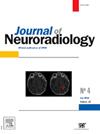Twig-like middle cerebral artery mimicking moyamoya syndrome : a case report and literature review.
IF 3
3区 医学
Q2 CLINICAL NEUROLOGY
引用次数: 0
Abstract
Background
Twig-like middle cerebral artery (T-MCA) is a rare vascular anomaly characterized by the replacement of the M1 segment of the middle cerebral artery (MCA) by a plexiform network of small vessels (1,2). This anomaly is often misdiagnosed due to its resemblance to Moyamoya disease (MMD), a progressive occlusive condition affecting the internal carotid artery (ICA) and associated with abnormal collateral vessel formation (1). While MMD typically involves bilateral ICA occlusion, T-MCA is unilateral and arises from an embryonic abnormality in MCA development (1). Awareness of T-MCA is crucial to avoid unnecessary or inappropriate treatments (1,3).
Aims The purpose of this case report is to highlight the clinical and radiological characteristics of twig-like middle cerebral artery (T-MCA) and its distinction from moyamoya disease (MMD). Given the rarity of T-MCA, which is often mistaken for MMD due to similar imaging patterns, this report aims to raise awareness of T-MCA as a separate congenital anomaly that can mimic progressive occlusive diseases like MMD. Accurate diagnosis is essential to avoid unnecessary treatments and to guide proper management for patients presenting with T-MCA.
Case Presentation
We present the case of a 57-year-old male who arrived at our institution with symptoms of sudden-onset headache, nausea, and vomiting. Initial CT imaging revealed a right MCA occlusion, raising suspicion for Moyamoya disease due to the plexiform arterial network. However, the MRI confirmed the diagnosis of T-MCA. The patient was managed conservatively due to the stable neurological status and absence of hemorrhagic stroke.
Discussion
T-MCA is a rare anomaly, identified in 0.11?1.17% of individuals undergoing angiography (4). Approximately 70% of affected individuals experience hemorrhagic stroke, 20% suffer ischemic events, and a minority remain asymptomatic (4,5). The most critical differential diagnosis is Moyamoya disease, which, unlike T-MCA, involves progressive bilateral ICA occlusion and basal ganglia moyamoya vessels (1). The differentiation between T-MCA and Moyamoya disease is essential due to the differing clinical implications and management approaches for these two conditions (3). T-MCA, although often mistaken for MMD, is a non-progressive vascular anomaly that is congenital in nature (1). MMD, on the other hand, is characterized by progressive stenosis or occlusion of the internal carotid artery (ICA) and its branches, which leads to the formation of compensatory basal ganglia collateral vessels (5). These compensatory vessels resemble a puff of smoke, or "moyamoya" in Japanese, as visualized on angiographic imaging (5). Misidentifying T-MCA as MMD can lead to overly aggressive treatments, including unnecessary surgical revascularization procedures intended for MMD (5). In our case, the patient presented with symptoms commonly associated with cerebrovascular events, including a sudden-onset headache, nausea, and vomiting. Initial imaging suggested a right MCA occlusion, raising suspicion for Moyamoya disease due to the appearance of a plexiform network. However, further MRI studies confirmed a stable, non-progressive T-MCA anomaly, allowing us to avoid more invasive interventions and opt for conservative management. In this case, the unilateral nature of the occlusion and lack of progressive stenosis of the ICA terminals differentiated T-MCA from MMD (1). The underlying pathology of T-MCA is rooted in a developmental anomaly, wherein the MCA fails to complete its formation, resulting in a plexiform arterial network instead of a single, well-formed M1 segment (1). This congenital defect is thought to occur early in embryonic development, distinguishing T-MCA?s etiology from the progressive occlusive nature of MMD (1). Due to its rarity, T-MCA is frequently undiagnosed or misdiagnosed, especially in cases where imaging reveals extensive collateral vessels mimicking Moyamoya disease (1). Given the high risk of hemorrhagic stroke in T-MCA patients, awareness of this anomaly is critical (6). Clinicians and radiologists should maintain a high index of suspicion when unilateral MCA abnormalities are detected without accompanying ICA stenosis (5). This distinction can be critical in tailoring treatment plans, particularly when the patient's neurological symptoms are stable and the risk of invasive intervention outweighs potential benefits (5). Further research into T-MCA is needed to better understand its clinical trajectory and to establish guidelines for optimal management (6). Data on the natural history, prevalence, and potential risk factors for ischemic or hemorrhagic events in T-MCA patients are limited, necessitating larger studies and registry-based data collection (6). Such insights would assist clinicians in balancing the benefits and risks of various treatment strategies and, importantly, in avoiding the overtreatment often associated with misdiagnosis (6).
Conclusion
The distinction between T-MCA and Moyamoya disease is essential for appropriate management and treatment planning. T-MCA should be considered in cases where unilateral MCA occlusion and plexiform networks are observed. Recognition of this rare anomaly will help avoid misdiagnosis and unnecessary interventions, particularly in patients with stable neurological symptoms. Further research and data collection are needed to fully understand the clinical implications and optimal management strategies for T-MCA.
模拟烟雾综合征的大脑中动脉细枝状1例报告并文献复习。
细枝状大脑中动脉(T-MCA)是一种罕见的血管异常,其特征是大脑中动脉(MCA)的M1段被网状小血管取代(1,2)。这种异常经常被误诊,因为它与烟雾病(MMD)相似,烟雾病是一种影响颈内动脉(ICA)的进行性闭塞疾病,与侧支血管形成异常有关(1)。虽然MMD通常涉及双侧ICA闭塞,但T-MCA是单侧的,是由MCA发育过程中的胚胎异常引起的(1)。了解T-MCA对于避免不必要或不适当的治疗至关重要(1,3)。目的探讨大脑中动脉(T-MCA)的临床和影像学特征,并与烟雾病(MMD)进行区分。鉴于T-MCA的罕见性,由于相似的成像模式,它经常被误认为是烟雾病,本报告旨在提高人们对T-MCA作为一种单独的先天性异常的认识,它可以模拟烟雾病等进行性闭塞性疾病。准确的诊断是必不可少的,以避免不必要的治疗,并指导适当的管理患者提出T-MCA。我们报告一个57岁男性的病例,他以突然发作的头痛、恶心和呕吐的症状来到我们的机构。最初的CT图像显示右MCA闭塞,由于网状动脉,引起对烟雾病的怀疑。然而,MRI证实了T-MCA的诊断。由于神经系统状态稳定且无出血性中风,患者接受保守治疗。t - mca是一种罕见的异常,在接受血管造影的个体中发现了0.11% - 1.17%(4)。大约70%的受影响个体经历出血性卒中,20%发生缺血性事件,少数无症状(4,5)。最关键的鉴别诊断是烟雾病,与T-MCA不同,它涉及进行性双侧ICA闭塞和基底神经节烟雾血管(1)。由于这两种疾病的临床含义和治疗方法不同,因此区分T-MCA和烟雾病是必不可少的(3)。T-MCA虽然经常被误认为烟雾病,但本质上是一种先天性的非进行性血管异常(1)。以颈内动脉(ICA)及其分支进行性狭窄或闭塞为特征,导致代偿性基底神经节侧支血管的形成(5)。这些代偿性血管在血管成像上看起来像一团烟雾,或日语中的“烟雾”(5)。将T-MCA误诊为烟雾病可能导致过度积极的治疗,包括针对烟雾病的不必要的外科血运重建手术(5)。患者表现出通常与脑血管事件相关的症状,包括突发性头痛、恶心和呕吐。最初的影像显示右侧中动脉闭塞,由于出现丛状网络,引起对烟雾病的怀疑。然而,进一步的MRI研究证实了一个稳定的,非进行性的T-MCA异常,允许我们避免更多的侵入性干预和选择保守管理。在本例中,单侧闭塞的性质和ICA末端缺乏进行性狭窄将T-MCA与烟雾病区分(1)。T-MCA的潜在病理根源于发育异常,其中MCA未能完成其形成,导致网状动脉网络而不是单一的,结构良好的M1段(1)。这种先天性缺陷被认为发生在胚胎发育早期,将T-MCA与烟雾病区分。由于其罕见性,T-MCA经常未被诊断或误诊,特别是在影像学显示广泛的侧支血管酷似烟雾病的情况下(1)。鉴于T-MCA患者出血性卒中的高风险,意识到这种异常是至关重要的(6)。当检测到单侧MCA异常而不伴有ICA狭窄时,临床医生和放射科医生应保持高度的怀疑指数(5)。这种区分对于制定治疗计划至关重要。特别是当患者的神经系统症状稳定且侵入性干预的风险大于潜在益处时(5)。需要对T-MCA进行进一步研究,以更好地了解其临床轨迹并建立最佳管理指南(6)。关于T-MCA患者的自然病史、患病率和缺血性或出血事件的潜在危险因素的数据有限。需要更大规模的研究和基于注册的数据收集(6)。这些见解将有助于临床医生平衡各种治疗策略的收益和风险,重要的是,避免过度治疗通常与误诊相关(6)。
本文章由计算机程序翻译,如有差异,请以英文原文为准。
求助全文
约1分钟内获得全文
求助全文
来源期刊

Journal of Neuroradiology
医学-核医学
CiteScore
6.10
自引率
5.70%
发文量
142
审稿时长
6-12 weeks
期刊介绍:
The Journal of Neuroradiology is a peer-reviewed journal, publishing worldwide clinical and basic research in the field of diagnostic and Interventional neuroradiology, translational and molecular neuroimaging, and artificial intelligence in neuroradiology.
The Journal of Neuroradiology considers for publication articles, reviews, technical notes and letters to the editors (correspondence section), provided that the methodology and scientific content are of high quality, and that the results will have substantial clinical impact and/or physiological importance.
 求助内容:
求助内容: 应助结果提醒方式:
应助结果提醒方式:


